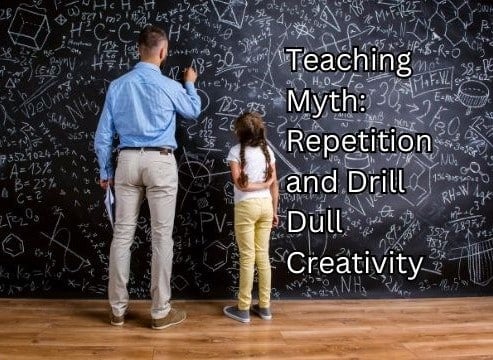
Repetition and drill have become swear words in education. Today, this form of learning is considered to be “out of style,”1 “ghastly boring,”2 and even “mindless.”3 Drill-and-practice, teachers are told, produces only rote memorization and dulls creativity.4 “Having to spend long periods of time on repetitive tasks is a sign that learning is not taking place — that this is not a productive learning situation,” says Bartoli.5
Some say that drill and practice of basic skills do not contribute to the achievement of literacy or higher-order thinking skills and that class time can be better spent in more enjoyable activities that will contribute to a deeper understanding. Kohn contends that “a growing facility with words and numbers derives from the process of finding answers to their own questions.”6 In other words, it is unnecessary to provide students with drills and practice on basic academic tool skills. Instead, teachers need only to encourage children to ask and to solve questions they may have. In the process of constructing their own meanings from these activities, the students will become fluent readers and skilled calculators.7
“This sounds wonderful,” says William Heward in an article for the Journal of Special Education, “I would welcome evidence of the phenomenon. It also places the cart before the horse, for it is facility with words and numbers that gives students the tools they need to solve problems and find answers to questions they or others may ask.”8
Heward continues: “Compare the attitudes and approaches to drill and practice by many academic teachers with the attitudes of educators who are held accountable for the competence of their students. The basketball coach or the music teacher needs no convincing regarding the value of drill and practice on fundamental skills. No one questions the basketball coach’s insistence that his players shoot 100 free throws every day or wonders why the piano teacher has her pupils play scales over and over. It is well understood that these skills are critical to future performance and that systematic practice is required to master them to the desired levels of automaticity and fluency. We would question the competence of the coach or music teacher who did not include drill and practice as a major component of his or her teaching.”9
In a major review of research on what teachers can do to influence student achievement, Brophy drew this conclusion on the relationship between drill and practice and creative performance:Development of basic knowledge and skills to the necessary levels of automatic and errorless performance requires a great deal of drill and practice. . . . drill and practice activities should not be slighted as “low level.” Carried out properly, they appear to be just as essential to complex and creative intellectual performance as they are to the performance of a virtuoso violinist.10 As Heward points out, drill and practice can be conducted in ways that render it pointless and a waste of time. “Research has shown, however, that when properly conducted, drill and practice is a consistently effective teaching method. For example, a recent meta-analysis of 85 academic intervention studies with students with learning disabilities found that regardless of the practical or theoretical orientation of the study, the largest effect sizes were obtained by interventions that included systematic drill, repetition, practice, and review (Swanson & Sachse-Lee, 2000).”11
Research has also shown that repetition is vital in the “wiring” of a person’s brain, i.e., the forming of connections or synapses between the brain cells. Without these connections, the brain cells are as useless as batteries standing in a row next to a flashlight. Only when the batteries and flashlight are connected, can they make a shining light.
The thing that wires a child’s brain, say neuroscientists — or rewires it after physical trauma — is “repeated experience.”12 Without such repeated experience, key synapses don’t form. And if such connections, once formed, are used too seldom to be strengthened and reinforced, the brain, figuring they’re dead weight, eventually “prunes” them away.13
Unless educators teach according to viable and universal learning principles, they cannot blame children for learning failure and learning disabilities.
Edublox offers cognitive training and live online tutoring to students with dyslexia, dysgraphia, dyscalculia, and other learning disabilities. Our students are in the United States, Canada, Australia, and elsewhere. Book a free consultation to discuss your child’s learning needs.
References:
1.) Bremmer, J., “What business needs from the nation’s schools,” St. Louis Post-Dispatch, 19 April 1993.
2.) Bassnett, S., “Comment,” Independent, 14 October 1999.
3.) Dixon, R-C. D., “Ideologies, practices, and their implications for special education,” Journal of Special Education, 1994, vol. 28, 356.
4.) Heward, W. L., “Ten faulty notions about teaching and learning that hinder the effectiveness of special education,” Journal of Special Education, January 2003.
5.) Bartoli, J. S., “An ecological response to Coles’s interactivity alternative,” Journal of Learning Disabilities, 1989, vol. 22(5), 292-297.
6.) Kohn, A., What to look for in a classroom. (San Francisco: Jossey-Bass, 1998).
7.) Heward, “Ten faulty notions about teaching and learning that hinder the effectiveness of special education.”
8.) Ibid.
9.) Ibid.
10.) Brophy, J., “ Teacher influences on student achievement,” American Psychologist, vol. 41, 1069-1077.
11.) Heward, “Ten faulty notions about teaching and learning that hinder the effectiveness of special education.”
12.) Nash, J. M., “Special report: Fertile minds from birth, a baby’s brain cells proliferate wildly, making connections that may shape a lifetime of experience. The first three years are crucial,” Time, 3 February 1997.
13.) Polaneczky, R., “How kids get smart: The surprising news,” Redbook, 1 March 1998.
